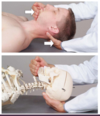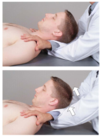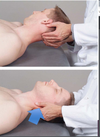Myofacial Release Flashcards
cerivical traction/supine traction
cradle occiput, apply axial cephalad traction rythmically; force maintained until tissue soft/relaxed

C-spine: unilateral forearm fulchrum forward bending
rotation towards elbow stretches trapezius, rotation toward hand stretched posterior scalene; flex cervical spine (from the knees); rhytmical or constant; TART before and after, REPEAT on OPPOSITE SIDE***

C-spine: Bilateral forearm fulchrum forward bending
repetively flex pt’s neck giving longitudinal stretch to the cervical paravertebral muscles; rhythmical/constant till soft/relaxed

C-spine: contralateral traction
supine, caudad hand reaches across to paravertebral muscles (*lateral to spinous processes), cephalad hand on pt forehead pushing in opposing direction, engage tissue with ventral/lateral force creating perpendicular stretch, do both side*

C-spine: cradling with traction
supine, fingers under pts neck BILATERALLY on paraspinal muscles; engage soft tissue w/ anterolateral force=perpendicular stretch; longitudinal traction toward cephalad; GOAL: relax cervical spine tissues

Head & C-spine: suboccipital release
fingers placed in subocciptal region, curl fingers, apply anterior P; maintain steady force, PALPATING for release of tension; kneading: slow and rhythmic or inhibition: constant P

Thoracic: prone pressure
thenar (thumb) and hypothenar (pinky) eminence on paravertebral muscles opposite to side you’re standing on; stack hands; elbows straight, use body weight to engage tissue w/ ventrolateral force = perpendicular stretch, GOAL: relax thoracic paraspinal tissue

Thoracic: prone pressure w/ counter pressure
cephalad hand- hypothenar on ipsi- paravertebral muscles, cuadad hand-thenar on contra- paravertebral muscles; engage tissue w/ ventral f. and move in dirction of fingers = longitudinal stretch, rhythmical manner until tissues are relaxed

Thoracic: subscapular stretch
prone or lateral recumbent; pts arm behind back; fingers in medial border of scapula; engage tissue with anterolateral traction, pull scapula away from rib cage, maintained until tissue softens

Upper thoracic: shoulder block lateral recumbent
lateral recumbent, face pt, caudad hand under pt arm contact thoracic paravertebral muscles, cephalad hand on ant. shoulder providing counterforce to caudads’ anterolateral force= perpendicular stretch, rhythmical manner until soft, BOTH* sides

Lower Thoracic: under the shoulder lateral recumbent
lateral recumbent, fingers on lower thoracic paravertebral muscles, engage w. anterolateral force= perpendicular force, rhythmical manner until tissues soft, BOTH sides*

Lumbar: prone pressure
thenar & hypothenar eminence on lumbar paravertbral muscles opposite to side you’re standing on, one hand on top of another, elbows straight, anterolateral force=perpendicular stretch, rhythmical manner, GOAL: relax lumbar paraspinal muscles

Lumbar: prone pressure w/ counterleverage
stand opposite to side treated, caudad hand in contra- ASIS, thenar+hypothenar eminence of cephalad hand on lumbar paraspinal muscles, pull ASIS posteriorly to counteract anterolateral P of cephalad hand = perpendicular stretch, rhythmic motion, reassess TART

Lumbar: paraspinal perpendicular stretch lateral recumbent
face pt, fingers on paravertebral muscles, engage w. anterolateral force= perpendicular stretch, rhytmical manner until tissue soft, BOTH sides*

Iliotibial Band prone
stand opposite to side being treated, caudad hand to grad ankle flex knee to 90°, cephalad hand along lateral thigh, iliotibial tissue, lateral force to ankle, engage IT band by pulling in posteromedial direction, rhythmical manner until softened








